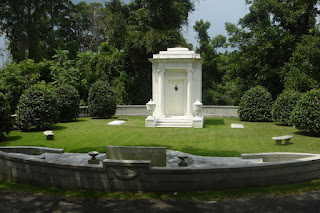Who
are the Trasks?
By: Ben Steelman
Star News
Star News
 |
| Trask Family Plot, Oakdale Cemetery Wilmington NC |
The
patriarch of the clan, Daniel Webster “Web” Trask (1847-1930) was born into a
relatively poor farming family in the Masonboro Sound area of New Hanover
County
A
compulsive reader of farm magazines, Web Trask had the idea to cover his beds —
first with boards and later with cheesecloth — to protect his plantings, so he
could get his produce to market two or three weeks earlier than anyone else’s.
By 1890, his crop was so big, he shipped his surplus north on the Atlantic Coast
Line railroad and began to cultivate buyers in New York
The
Trask produce business would really take off, however, under Web’s son George
W. Trask (1876-1963). A hard worker, the younger Trask started off around 1897
with a small farm, Blythe Savannah, in the Winter Park
In
1902, however, with money borrowed from his father, George Trask bought a farm
in the Wrightsboro community, close to the Atlantic
Coast Line tracks, from his uncle
Christian H. Heide (who suffered from tuberculosis and wanted to move to the North Carolina
Within
two years, George W. Trask had paid off his father, and by 1907, he could
afford to have Wilmington architect Henry Bonitz build a spacious farmhouse for
his family — later known in family lore as “The Big House.” Carefully investing
his profits, he steadily bought more land, until the family tracts amounted to
thousands of acres. Bringing in his sons as partners, he founded George W.
Trask & Sons to handle the northern export business. By the time of his
death, his obituary in the Morning Star hailed him as “the first commercial
planter of field green lettuce on the Eastern seaboard.”
In
his spare time, George W. Trask served as a New Hanover
County
Among
George Trask’s children was C. Heide Trask (1902-1957), who followed his father
into the family business and worked intensively on refrigerating produce. C.
Heide Trask was chairman of New Hanover County ’s
Selective Service (draft) board, 1940-1955, and was chairman of the board of James Walker
Memorial Hospital State Highway Wrightsville
Beach
Another
of George W. Trask’s sons was Raiford Graham Trask (1916-1993), who ended up
leading the family in new directions. He developed a number of Wilmington
subdivisions on former Trask farmland, including College Acres, Long Leaf Acres
and Kings Grant, and he was co-developer of Figure Eight Island and the Duck
Haven Golf Club. He also built several shopping centers.
Like
others in his family, Raiford Trask entered politics. He served on the Wrightsville Beach
Town Council and was mayor of Wrightsville Beach ,
a New Hanover
County Commissioner (1952-1956) and a
trustee of Wilmington
College University of North
Carolina Wilmington New Hanover
County Trask Middle
School
Many
members of the Trask family are buried at Wilmington ’s
Oakdale Cemetery
“The Trask Family — 1986″ by
George Graham Trask provides much genealogical data, and “The Carolina
Date posted: June 3, 2009
User-contributed question by:
Linda RooksRichardson
Linda Rooks




































